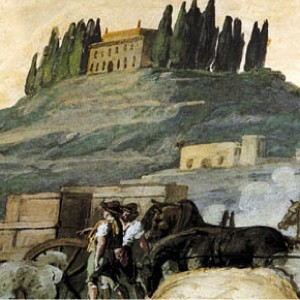
Historical background
| 1611 | Paul V implemented the project to build the Novum Archivum in the Apostolic Palace and collected some registers and volumes from the Vatican Library, the Apostolic Chamber and the Castel Sant’Angelo Archives, the Archivum Vetus, in the Paoline Room adjacent to the present-day Sistine Hall of the Vatican Museums. The Castel Sant’Angelo Archives continue to house the oldest, most precious documents of the Holy See carefully stored in wooden armaria and arranged geographically. The pope appointed Michele Lonigo “prefect of the bulls and registers of the Vatican Library” to supervise the new archives. |
| 1612 | January 31. Paul V appointed Baldassarre Ansidei, former custodian of the Vatican Apostolic Library, custodian of the new archives. The official history of the Archivio Apostolico Vaticano dates back to this day, and today the Archives are still a sort of «department» of the Papal Library. |
| 1613-1614 | The documentary material collected by Paul V in the Paoline Room was then housed in the three rooms on the piano nobile in the present-day Archivio Apostolico Vaticano the Pius IV wing of the Apostolic Palace next to the Sistine Hall of the Museums. |
| 1630 | July 23. Urban VIII granted the Archivio Segreto Vaticano autonomy from the Apostolic Library. |
| 1646 | The name “Vatican Secret Archives” appears for the first time in a general index drawn up by the Prefect, Costanzo Centofiorini. From then on, it became the official title of the archive founded by Paul V. |
| 1660 | Alexander VII assigned the floor above the three Paoline Rooms to the Archivio Segreto Vaticano and set it aside for the conservation of the Secretariat of State Archives. |
| 1798 | The Castel Sant’Angelo Archives were transferred to the Archivio Segreto Vaticano along the Passetto di Borgo. |
| 1810 | Napoleon Bonaparte seized the papal archives and transferred them to Paris starting from February of the same year. About 3,239 cases or baskets of documents from the Archivio Segreto Vaticano and other archives of the Roman Curia left Rome on enormous wagons. |
| 1814 | Procedures were initiated to return the papal archives from Palais Soubise in Paris to the Holy See. |
| 1815 | February-June. After Napoleon temporarily regained power - the so-called Hundred Days - operations to return the archives to the Holy See were suspended. |
| 1816-1817 | Several convoys transported back to Rome the rest of the documents Napoleon had seized from the Holy See and transferred to Paris. The high transport costs involved prompted the papal commissioners to destroy hundreds of documents that were considered “useless” and to sell thousands as wastepaper. Many documents belonging to the archives were lost in transit, and some papers and documents were delivered to the wrong place and did not end up in the original archives. |
| 1881 | Leo XIII opened the doors of the Archivio Segreto Vaticano to scholars of all faiths from all nations. |
| 1884 | May 1. The new Regolamento dell’Archivio Segreto Vaticano was approved and set the functions of the persons in charge and their staff. It also regulated admission procedures for scholars. |
| 1980 | October 18. John Paul II inaugurated the new storerooms (Bunker) under the Cortile della Pigna of the Vatican Museums. |
| 2019 | October 22. Pope Francis, with his Apostolic Letter in the form of a motu proprio entitled “Historical experience”, restored the original name of "Vatican Apostolic Archives". |
